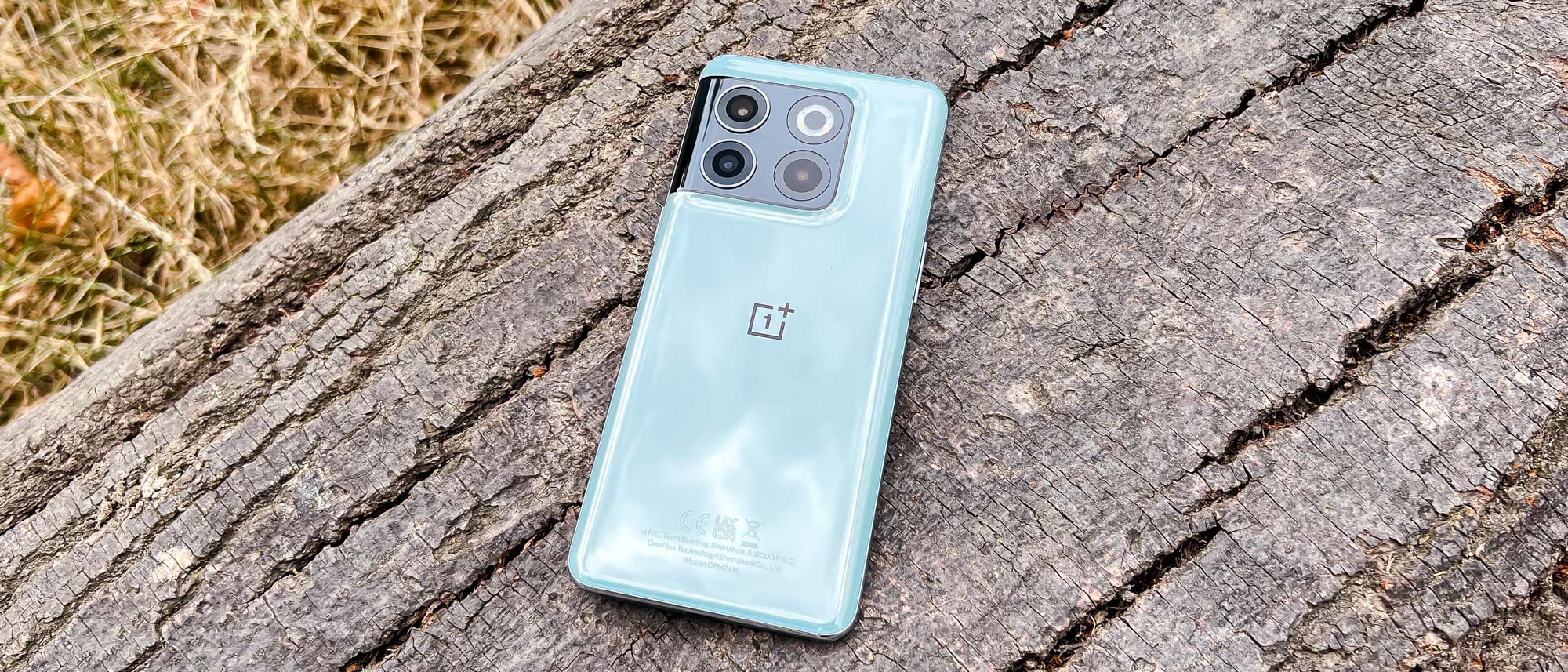Tom's Guide Verdict
The OnePlus 10T targets power users with top-tier performance and charging plus good battery life. And it's $150 less than the OnePlus 10 Pro. But OnePlus drops features like wireless charging, a telephoto camera and more, making the OnePlus 10T a device with weirdly limited appeal when compared to the Google Pixel 6 Pro or the OnePlus 10 Pro.
Pros
- +
Super-speed charging
- +
Strong performance
- +
Good battery life
- +
More affordable than many flagships
Cons
- -
Weaker cameras than the OnePlus 10 Pro
- -
No wireless charging
- -
Display refresh rate doesn’t dynamically adjust
Why you can trust Tom's Guide
Starting price: $649/£629
Display: 6.7-inch FHD AMOLED (2412 x 1080)
Refresh rate: 120Hz/90Hz/60Hz
Chipset: Snapdragon 8 Plus Gen 1
RAM: 8GB/16GB
Storage: 128GB/256GB
Rear cameras: 50MP main (f/1.8), 8MP ultrawide (f/2.2), 2MP macro
Front camera: 16MP (f/2.5)
Battery: 4,800 mAh
Charging: 150W wired
Software: Android 12 with OxygenOS 12.1
Size: 6.4 x 3 x 0.34 inches(163 x 75.3 x 8.7mm)
Weight: 7.2 oz (203g)
There's nothing overtly wrong with the OnePlus 10T. But over the course of reviewing the latest high-end device from OnePlus, I couldn't help but feel this handset traded away its character in favor of performance gains, like a friend who suddenly gets too into working out.
For this mid-life revision of the OnePlus 10 Pro, OnePlus decided to strip out a lot of what makes the OnePlus 10 Pro one of the best Android phones. Instead, the focus with the 10T is more on speed and power. The phone’s new silicon and charging standard offer impressive results, but it's hard to see that the extra performance and $150 cheaper start price is worth missing out on the better display, Hasselblad cameras, and the ever-convenient OnePlus alert slider that you get with the older model.
Unlike the 10 Pro, which is not only a top Android device but one of the best phones on sale today, the OnePlus 10T has more of a niche appeal as a result of these radical revisions. Blending computing and charging power with a refined interface, it's great if you love mobile gaming or need to use your phone more than most throughout the day. Still, there are too many conventional flagship phone features missing to make this a phone you need to shortlist. (You can check out our full comparison between OnePlus 10T vs. OnePlus 10 Pro as well).
OnePlus 10T review: Price and availability
OnePlus will be selling the OnePlus 10T from August 25 in the U.K. The U.S. is in for a slightly longer wait, with pre-orders opening on September 1, and general availability starting September 29.
Prices start at $649/£629 for 8GB RAM and 128GB storage, or $749/£729 for 16GB RAM and 256GB storage. The OnePlus 10 Pro costs $799 currently from OnePlus, or £799 in the U.K.
Looking at rival phones, the OnePlus 10T undercuts the Samsung Galaxy S22, iPhone 13 and Pixel 6 Pro by roughly a $150/£100 margin, and the equivalent-sized Galaxy S22 Ultra and iPhone 13 Pro Max by even more. However, if you want to get the most out of the phone's performance with the 16GB RAM version, then the gap isn't quite as wide.
OnePlus 10T review: Design
Looking at the OnePlus 10T from the back, you can see the family resemblance with the OnePlus 10 Pro. The back of the phone features the same style of bump as the 10 Pro, except the back glass now curves up to meet it instead of there being two distinct levels. I think it's another good-looking spin on the original design but I still prefer the 10 Pro's look.
Get instant access to breaking news, the hottest reviews, great deals and helpful tips.
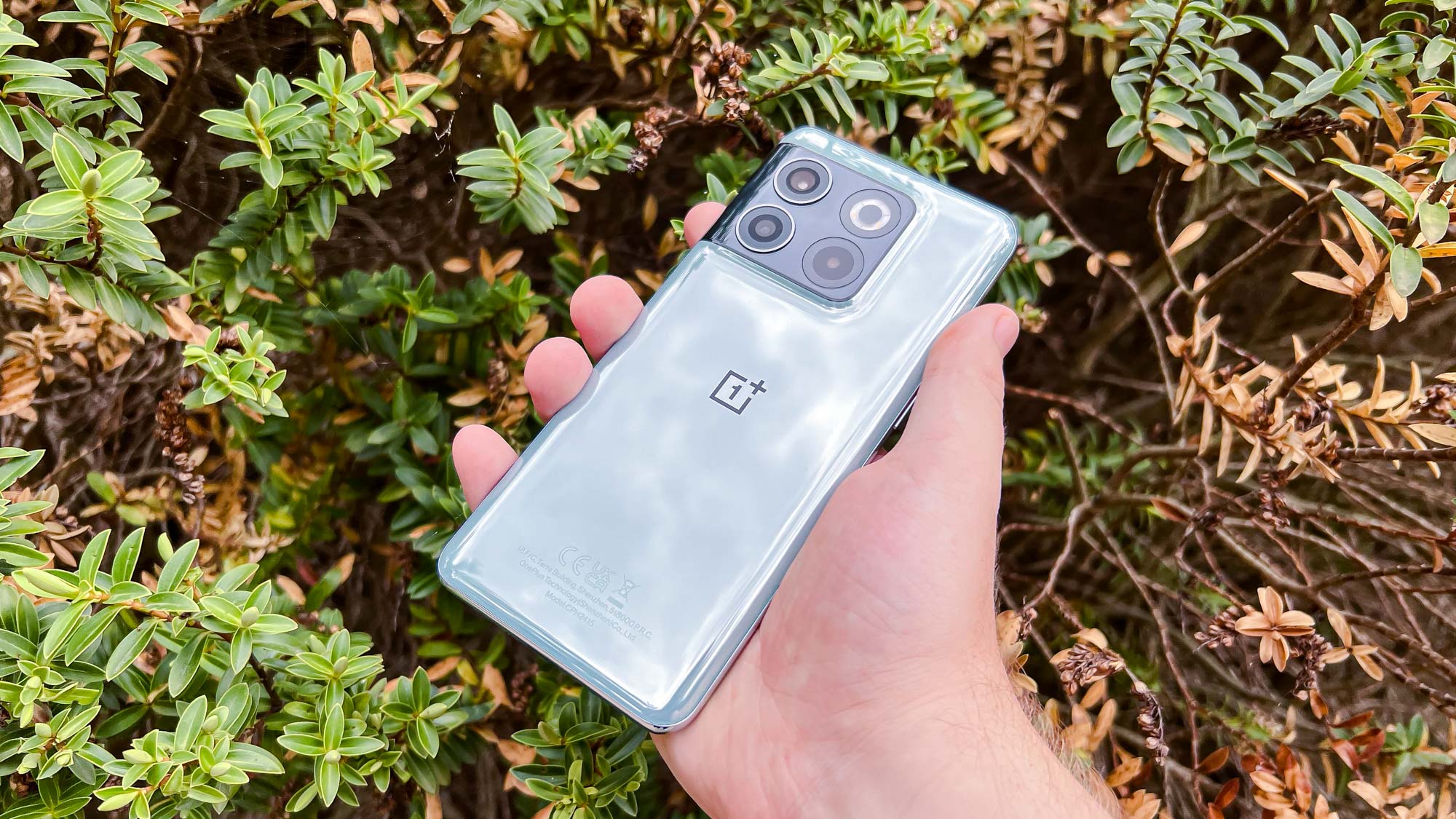
On the front, the selfie camera's moved from OnePlus' usual left corner to the center of the display. The screen is also flat instead of curved, which will please users who are particularly annoyed by potential mistouches on curved screens.
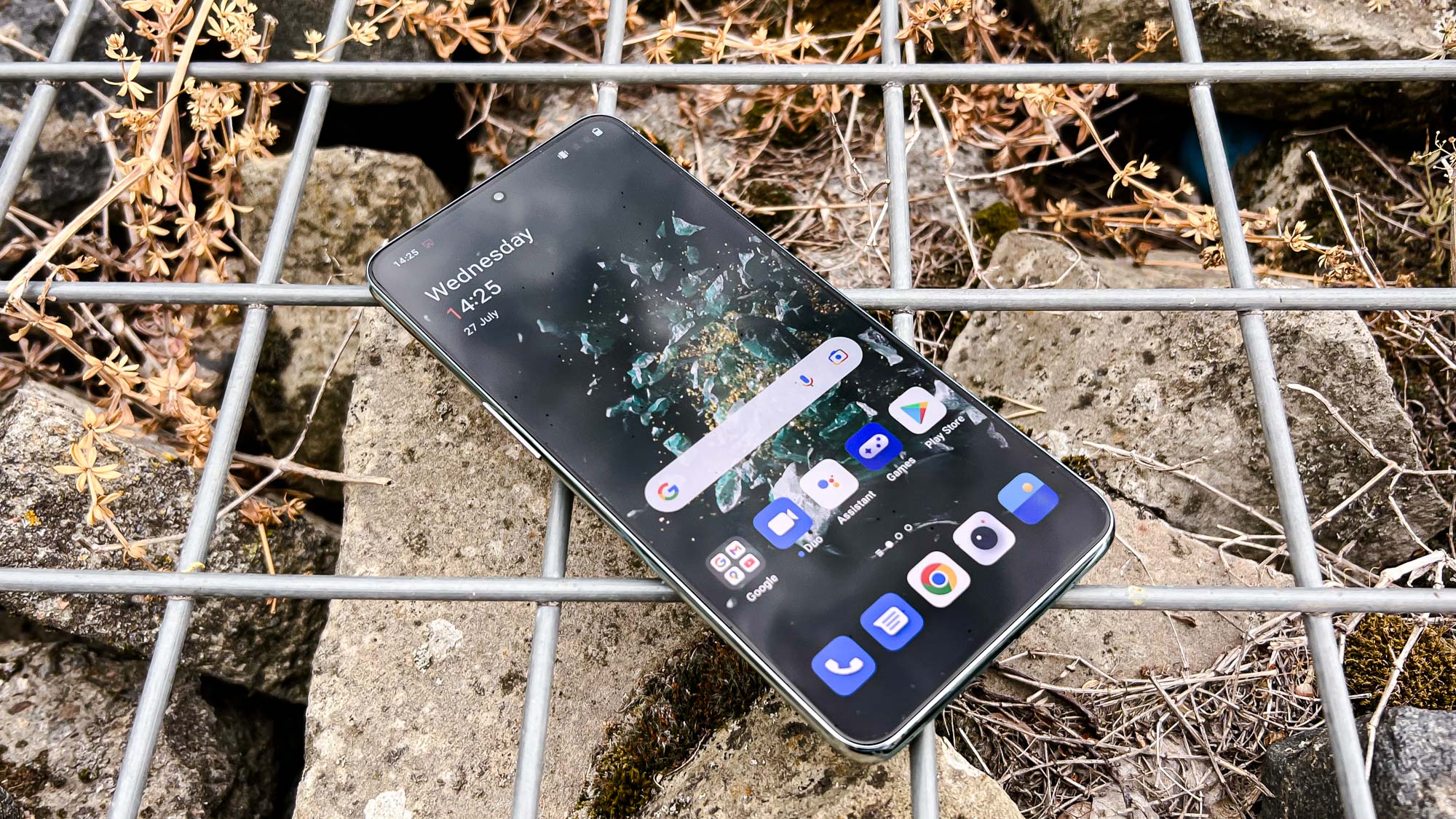
However, the sides and back of the OnePlus 10T are still curved, which combined with the phone's slim profile and below average weight make it very comfortable to use.

I don't normally pay much attention to a phone's sides, but we have to here because — horror of horrors — they're metalized plastic instead of metal like the OnePlus 10 Pro. Even worse, there's no alert slider.
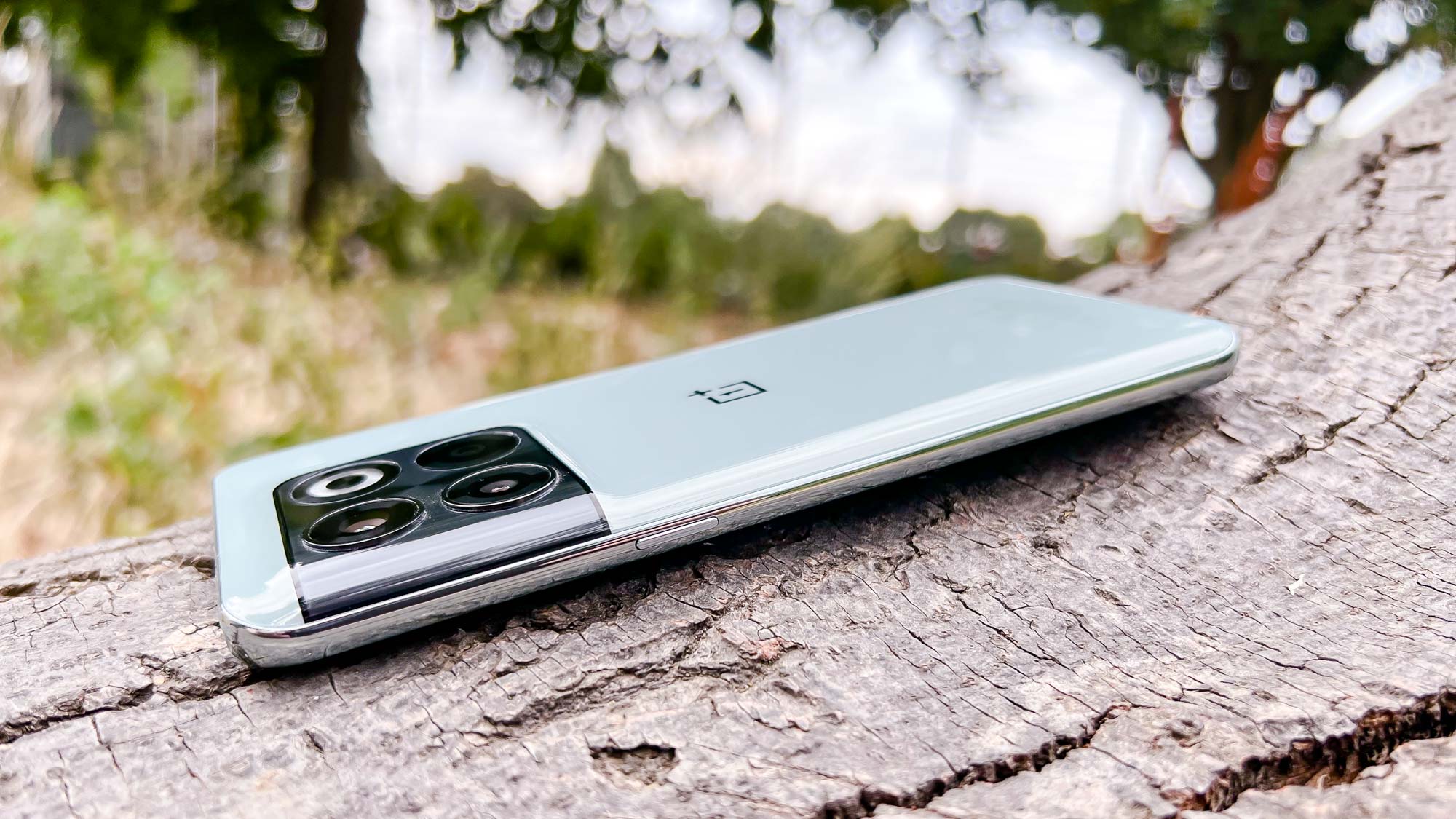
This is because OnePlus decided to use the room normally taken up by the slider for more battery, faster charging and improved 5G connectivity. Still, it’s sad to see the slider’s departure, as it was one of the most distinctive things about OnePlus phones. I think I'd rather it stayed instead of the other upgrades, because as we'll see later on, OnePlus is hardly struggling for battery capacity or charging speed.
Your color choices for the OnePlus 10T are either the glossy (and smudge-prone) Jade Green (the color of this review unit) or the matte-textured Moonstone Black. I say choices but annoyingly in the U.K. OnePlus has locked these colors to specific memory variants. Green's only on offer on the 16GB model, and Black on the 8GB model. OnePlus has done this before on other phones but it's no less annoying than before.

The OnePlus 10T scores limited points for durability. It uses Gorilla Glass 5 on the front and back, which isn't as tough as the Gorilla Glass Victus used on rival Android flagship phones. Also, in typical OnePlus fashion, there's no official no IP rating — just a promise that the phone's "splashproof." Hopefully this phone will never take a dip into a lake or a pile of gravel and this won't have to be put to the test, but considering how basically every other flagship phone maker guarantees IP68 resistance, it's weird that OnePlus doesn't.
OnePlus 10T review: Display
The OnePlus 10T uses a 6.7-inch FHD AMOLED display with HDR 10+ and 10-bit color. Although the 10T's display is nominally the same size as the Pixel 6 Pro and iPhone 13 Pro Max, it feels a lot smaller thanks to a narrower design and the curved back.

Watching the trailer for Netflix's Marilyn Monroe biopic Blonde, the display looked to be just as colorful as the Galaxy S22 Ultra, and just as sharp for its size as it flashed through scenes of the Hollywood star's life. However, the OnePlus' maximum brightness was disappointingly low, making it hard to use the display when outside in direct sunlight.
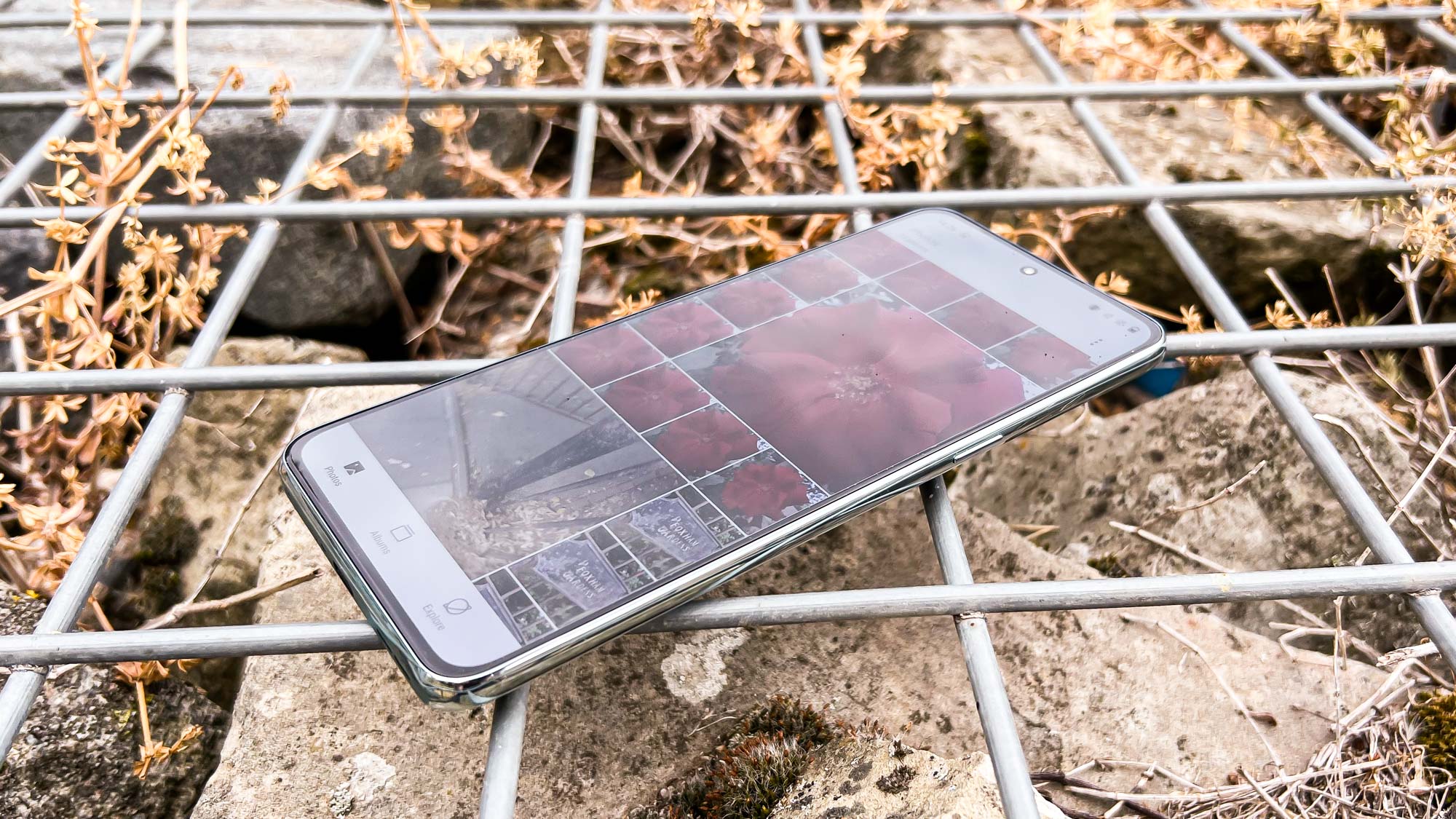
The display's refresh rate maxes out at 120Hz, and can scale down to 60Hz or 90Hz to conserve power. That's not as advanced as the fully adaptive LTPO 2.0 system on the OnePlus 10 Pro that can drop all the way to 1Hz, but this system should still help with power efficiency.
| Row 0 - Cell 0 | OnePlus 10T | Samsung Galaxy S22 Ultra | iPhone 13 Pro Max | Google Pixel 6 Pro |
| Max brightness | 727 nits | 1,359 nits | 1,038 nits | 842 nits |
| sRGB color gamut | 179.6% | 137.5% | 109.3% | 104.2% |
| DCI-P3 color gamut | 127.2% | 97.4% | 77.4% | 73.8 |
| Delta-E color accuracy (lower is better) | 0.31 | 0.25 | 0.21 | 0.3 |
As you can see in the table above, the numbers back up the OnePlus' display being quite dim. However, the color gamut results reveal that in the phone's default Vivid profile, it's able to show off images and video at their best thanks to the 10T’s support for detailed 10-bit color.

It's a shame the OnePlus 10T tallied the highest Delta-E score (lower numbers are better) of the phones we're comparing it against here, as that suggests the colors on the 10T’s screen aren’t as accurate as rival phones.
OnePlus 10T review: Cameras
The three cameras on the back of the OnePlus 10 Pro consist of a 50MP main shooter, 8MP ultrawide lens and a 2MP macro sensor, joined a 16MP selfie camera on the front. There's no Hasselblad tuning to be found here, as OnePlus says it is saving its best photography features for the OnePlus 10 Pro, You still get some advanced options like 10-bit photography though.
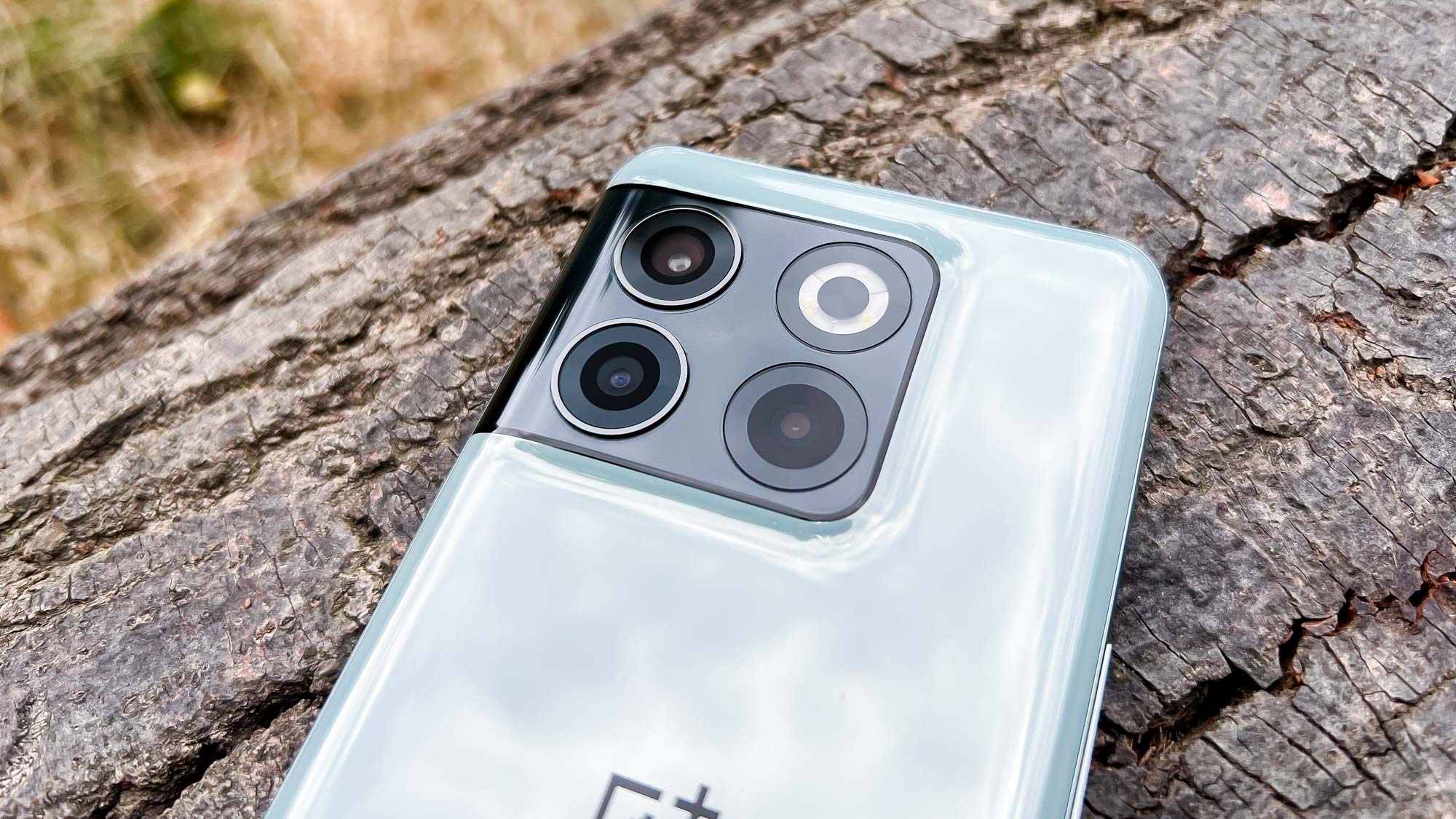
The main camera is the best single sensor on the phone, even without the help of Hasselblad. We can see in this shot that the OnePlus offers a cooler-colored image than the iPhone 13 Pro Max, and in some ways, I think it's a better representation of this park entrance sign. However, the 10T’s shot offers a little less detail than the iPhone, which while not an issue I found with wider shots, matters more when taking close-ups like this.
In this ultrawide comparison of a fallen log against the Samsung Galaxy S22 Ultra, we can see that OnePlus' image is a lot less saturated than the Galaxy's, and a bit smoother too. We can't put this purely down to the Galaxy S22 Ultra being a much more expensive phone either, since its ultrawide sensor is also used on the cheaper Galaxy S22 and Galaxy S22 Plus.
Macro cameras rarely perform well on phones, and the fact that OnePlus has put one on a flagship-grade phone feels like it's short-changing the user. Nonetheless, I tried the camera out against the Xiaomi 12, one of the only phones with a decent macro camera. This shot of the stamen of a flower isn't awful on the OnePlus since there was a decent amount of light available, but it can't match up to the Xiaomi, which uses a higher resolution sensor and a "telemacro" lens to take photos from a greater distance and allow more light in the shot.
Swapping back to the iPhone 13 Pro Max for a selfie portrait comparison, we again see the iPhone's tendency towards warmer shots.
I had to crank up the bokeh effect on the OnePlus' camera app to get a similar shot to the iPhone, and I suspect that is because OnePlus' inferior algorithm is unable to cut my head out from the background quite as neatly. It's still a good selfie, but the iPhone beats it here.
OnePlus 10T review: Performance
OnePlus put its focus on computer power with the 10T, and so it's turned to a Snapdragon 8 Plus Gen 1 processor — an upgrade over the standard Snapdragon 8 Gen 1 in the OnePlus 10 Pro — and a maximum of 16GB RAM instead of 12GB.
Weirdly, the results are a mixed bag. The Geekbench result for the OnePlus 10T is a bit low, although the Wild Life and Wild Life Extreme tests beat both the Pixel 6 Pro and Galaxy S22 Ultra. Yet, the iPhone 13 Pro Max still conquers all with its A15 Bionic chip. Also, the OnePlus 10T comes in dead last in the Adobe Premiere Rush video encoding test, despite its top-notch components.
| Row 0 - Cell 0 | OnePlus 10T | Samsung Galaxy S22 Ultra | Google Pixel 6 Pro | iPhone 13 Pro Max |
| Geekbench 5 (single / multicore) | 1,025/3,476 | 1,240 / 3,392 | 1,027 / 2,760 | 1,720 / 4,549 |
| 3DMark Wild Life Unlimited (Score / FPS) | 10,997 / 66 | 9,984 / 60 | 6,682 / 40 | 11,418 / 68 |
| 3DMark Wild Life Extreme (Score / FPS) | 2,752 / 16 | 2,346 / 14 | 1,832 / 11 | 3,075 / 18 |
| Adobe Premiere Rush (Mins:Secs) | 1:05 | 0:47 | 0:48 | 0:25 |
Even if the benchmark results for the OnePlus 10T are a bit inconsistent, I still had a fun time playing games like Grid: Autosport (at max graphics) and Apex Legends Mobile on the phone. In the latter, I was able to crank the game up to ExtremeHD graphics and Ultra frame rate without seeing any stuttering or the phone getting uncomfortably hot.
OnePlus 10T review: Battery and charging
Fuelling the OnePlus 10T is a 4,800 mAh battery, a touch smaller than the 5,000 mAh cell inside the OnePlus 10 Pro. On our custom battery life test, in which we have phones surf the web continuously over cellular until they run out of power, the 10T survived 10 hours and 59 minutes at its full 120Hz, and slightly longer at 11 hours 22 minutes when set to 60Hz.
The OnePlus 10T’s result beats the Galaxy S22 Ultra (10 hours 18 minutes at 60Hz) and Pixel 6 Pro (7 hours 55 minutes at 60Hz), but it's still about an hour short of the iPhone 13 Pro Max's impressive 12 hours 16 minutes result, which Apple’s phone achieved with its adaptive refresh rate active. Still, nearly 11 hours of battery life is nothing to sniff at.
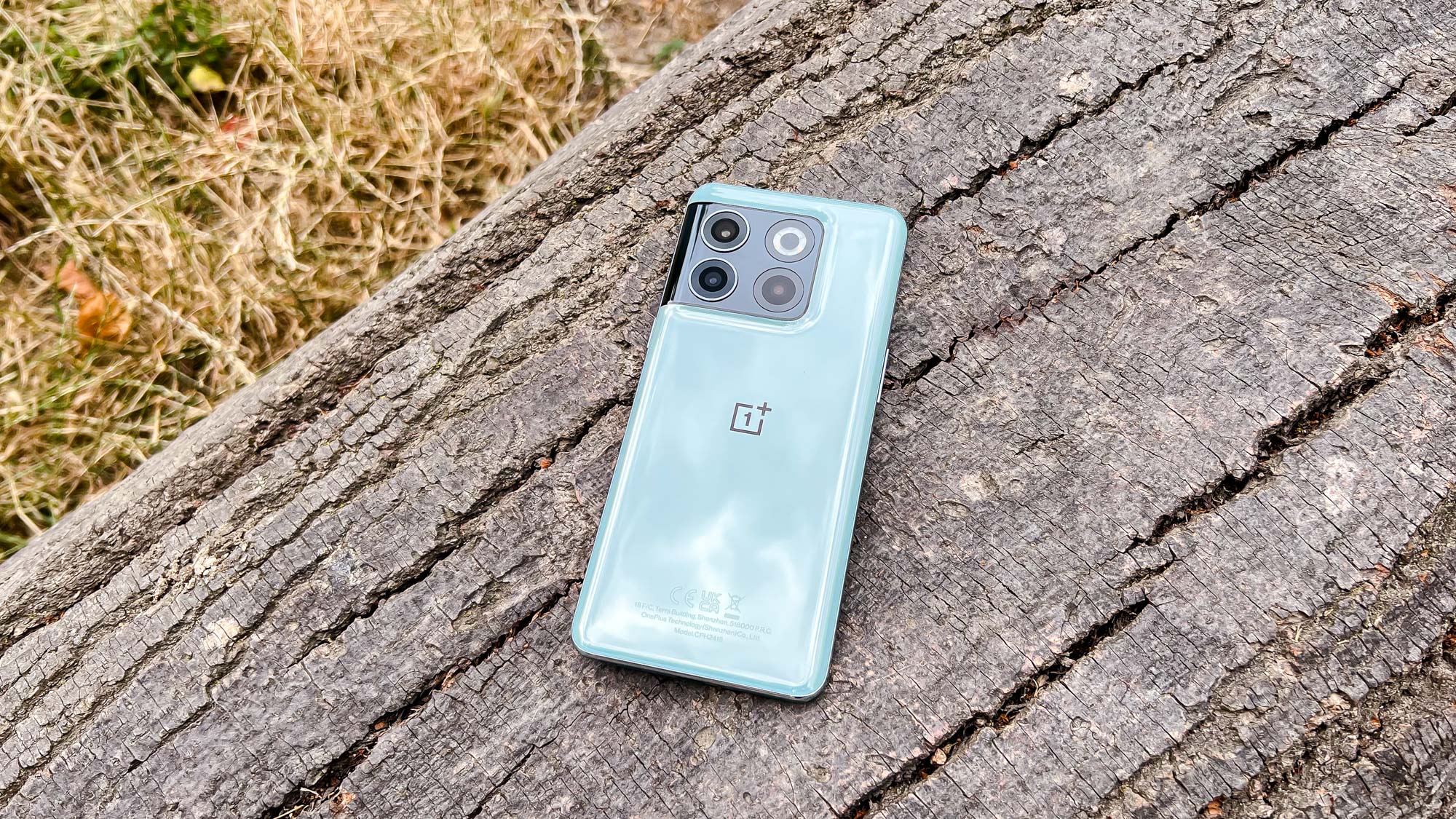
To power that battery up, OnePlus offers an almighty 150W charging system, via the included 160W USB-C charging brick. That gets you to 84% charge in 15 minutes and 100% charge in just 20 minutes, making the OnePlus 10T one of the fastest charging phones we've ever tried — it’s the very fastest if you measure by total milliamp hours filled in the shortest time.
High wattages like this can speed up battery degradation, but OnePlus assures users that after 1,600 cycles — basically, charging your phone once a day for more than four years — the battery will lose less than 20% of its original capacity.
Unlike the OnePlus 10 Pro, there's no wireless charging on the OnePlus 10T. It's not a critical feature, but it's something all the 10T's rivals have, even if it's only the basic 7.5W Qi standard. As a result, it feels like a big miss on the OnePlus 10T’s part, given its flagship status. But this was presumably another one of OnePlus' sacrifices to the altar of power.
OnePlus 10T review: Software
OnePlus ships the 10T with OxygenOS 12.1, with three years of full updates and four years of security updates promised. That's still below the four years of full OS updates that Samsung offers, and the five years of updates you get with Google. If you want to get the most out of your phone for the longest time, the OnePlus 10T may not be the ideal device.
There aren't any noteworthy new features this time around as OnePlus is focussing on its Android 13 skin for later this year, but OxygenOS remains enjoyable to use. Features like the Shelf, which allows access to certain widgets in any app (a la iOS' Control Center), a three-level adjustable Dark Mode and the implementation of Android 12's adaptive Material You color schemes all make it one of the nicest Android skins around.
OnePlus 10T review: Verdict
The OnePlus 10T is possibly the least OnePlus-y phone the company's ever produced. The revival of the flagship T-series brings with it both some market-leading features but at the expense of other elements falling below par, and some OnePlus signature abilities disappearing. The result is a strong and attractively priced phone, even if it’s an uneven one.
The 10T's focus on performance means in a direct comparison of features, it doesn't come off well. It’s missing wireless charging, a telephoto camera and a fully adaptive display refresh rate, which are all standards for most flagship phones. With a much cheaper start price though, there are still some people who may find the trade-off worthwhile.
The OnePlus 10T could make for an excellent gaming phone, except with the reassurance of well-designed software and no obnoxious design elements. Equally, it could be a great work companion, with the good battery life meaning you're not likely to be left in the lurch with 0% juice, and the outstanding charging making sure if that does happen, you won’t be with an un-powered device for long. If any of those three missing parts we mentioned above are deal breakers, and you aren't fussed by the OnePlus 10T's blistering performance, you could always go for the OnePlus 10 Pro, which costs more but offers a much better-rounded experience.
Beyond OnePlus, the Pixel 6 Pro (or the upcoming Pixel 7 Pro when the Pixel 7 family launches in the fall) is probably the phone to go for since it provides the 10T's missing features for a cheaper than average price, and offers particularly good photography to boot. The Galaxy S22 Ultra and iPhone 13 Pro/Pro Max would make excellent choices too, but those might be just out of your price range, while the regular Galaxy S22 and iPhone 13 don't match up for display size or charging speed.
Next: Here's everything we know about the OnePlus 11 Pro that could launch in 2023.

Richard is based in London, covering news, reviews and how-tos for phones, tablets, gaming, and whatever else people need advice on. Following on from his MA in Magazine Journalism at the University of Sheffield, he's also written for WIRED U.K., The Register and Creative Bloq. When not at work, he's likely thinking about how to brew the perfect cup of specialty coffee.
